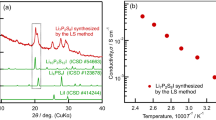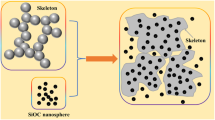Abstract
The application temperature and exposure time of lightweight, high performance aerogel insulation is limited by the thermal stability of the aerogel system used. Elevated temperatures cause rapid densification of the porous structures accompanied by increases in thermal conductivity and density. Previous studies have demonstrated the importance of doping concentration to thermal stability in doped metal oxide aerogel systems. The compositional route remains insufficient for stabilizing the pore structures of yttria-stabilized zirconia aerogels at elevated temperatures above 1100 °C. Non-compositionally, modifying synthetic parameters in the aerogel synthesis have been known to change the as dried pore structures. However, few studies have investigated the microstructure evolution of these pore structures under heat treatment. The current work investigates YSZ aerogels prepared via a sol-gel method at 30 mol% YO1.5, varying solids loadings and water contents. The results inform the ways in which the aerogel pore structure at high temperatures is sensitive and insensitive to the variation in synthetic parameters. An improved understanding of the relationships between synthetic parameters, as dried structure, and thermal stability will inform future efforts in the design and synthesis of aerogels with thermal stability in extreme environments.
Graphical Abstract

Solids loading and water content are used to vary the pore structure of yttria-stabilized zirconia aerogels. The evolution of the aerogels is studied to 1000 °C to elucidate changes in thermal stability as a function of as dried specific surface area, pore volume, and pore size
Highlights
-
Synthetic parameters of solids loading and water content modify the pore structure of YSZ aerogels.
-
Microstructural evolution of a full factorial set of aerogels is characterized to 1200 °C.
-
Higher specific surface areas contribute to significantly greater densification to 1000 °C.
-
The change in densification with synthetic parameters is small compared to change with composition.










Similar content being viewed by others
References
Pierre AC, Pajonk GM (2002) Chemistry of aerogels and their applications. Chem Rev 102:4243–4265. https://doi.org/10.1021/cr0101306
Aegerter M, Leventis N, Koebel M (2011) Aerogels handbook (Advances in Sol-Gel Derived Materials and Technologies)
Brinker CJ, Scherer GW (1990) Sol-gel science: the physics and chemistry of sol-gel processing
Al-Yassir N, Le Van Mao R (2007) Thermal stability of alumina aerogel doped with yttrium oxide, used as a catalyst support for the thermocatalytic cracking (TCC) process: An investigation of its textural and structural properties. Appl Catal A: Gen 317:275–283. https://doi.org/10.1016/j.apcata.2006.10.030
Hurwitz FI, Gallagher M, Olin TC et al. (2014) Optimization of Alumina and Aluminosilicate Aerogel Structure for High-Temperature Performance. Int J Appl Glass Sci 5:276–286. https://doi.org/10.1111/ijag.12070
Hurwitz FI, Rogers RB, Guo H et al. (2020) Phase development and pore stability of yttria- and ytterbia-stabilized zirconia aerogels. J Am Ceram Soc 103:6700–6711. https://doi.org/10.1111/jace.17376
Olson NS, Hurwitz FI, Guo H et al. (2021) Enhanced thermal stability of high yttria concentration YSZ aerogels. J Am Ceram Soc 104:4190–4202. https://doi.org/10.1111/jace.17792
Hurwitz FI, Rogers RB, Guo H et al. (2017) The role of phase changes in maintaining pore structure on thermal exposure of aluminosilicate aerogels. MRS Commun 7:642–650. https://doi.org/10.1557/mrc.2017.89
Folgar C, Folz D, Suchicital C, Clark D (2007) Microstructural evolution in silica aerogel. J Non-Crystalline Solids 353:1483–1490. https://doi.org/10.1016/j.jnoncrysol.2007.02.047
Clapsaddle BJ, Neumann B, Wittstock A et al. (2012) A sol-gel methodology for the preparation of lanthanide-oxide aerogels: Preparation and characterization. J Sol-Gel Sci Technol 64:381–389. https://doi.org/10.1007/s10971-012-2868-6
Suh DJ, Park TJ (1996) Sol-gel strategies for pore size control of high-surface-area transition-metal oxide aerogels. Chem Mater 8:509–513. https://doi.org/10.1021/cm950407g
Kilo M, Taylor MA, Argirusis C et al. (2003) Cation self-diffusion of 44Ca, 88Y, and 96Zr in single-crystalline calcia- and yttria-doped zirconia. J Appl Phys 94:7547–7552. https://doi.org/10.1063/1.1628379
Kilo M, Borchardt G, Lesage B et al. (2000) Cation transport in yttria stabilized cubic zirconia: 96Zr tracer diffusion in (ZrxY1-x)O2-x/2 single crystals with 0.15≤x≤0.48. J Eur Ceram Soc 20:2069–2077. https://doi.org/10.1016/S0955-2219(00)00072-8
Kilo M, Borchardt G, Lesage B et al. (2001) Y and Zr tracer diffusion in yttria-stabilized zirconia at temperatures between 1250 K and 2000 K. Key Eng Mater 206–213:601–604
Drazin JW, Castro RHR (2015) Phase stability in nanocrystals: A predictive diagram for yttria-zirconia. J Am Ceram Soc 98:1377–1384. https://doi.org/10.1111/jace.13504
Fabrichnaya O, Aldinger F (2004) Assessment of thermodynamic parameters in the system ZrO2-Y2O3-Al2O3. Zeitschrift für Metallkunde 95
Bisson JF, Fournier D, Poulain M et al. (2000) Thermal conductivity of yttria-zirconia single crystals, determined with spatially resolved infrared thermography. J Am Ceram Soc 83:1993–1998. https://doi.org/10.1111/j.1151-2916.2000.tb01502.x
Olson NS, Hurwitz FI, Stokes JL, et al. (2023) Thermal stability of M x O y ‐doped zirconia aerogels (M = Y, Yb, Gd, Ce, Ca) studied through 1200°C. J Am Ceram Soc Jace. 19380. https://doi.org/10.1111/jace.19380
Gash AE, Tillotson TM, Satcher JH et al. (2001) New sol-gel synthetic route to transition and main-group metal oxide aerogels using inorganic salt precursors. J Non-Crystalline Solids 285:22–28. https://doi.org/10.1016/S0022-3093(01)00427-6
Gash AE, Tillotson TM, Satcher JH et al. (2001) Use of Epoxides in the Sol-Gel Synthesis of Porous Iron(III) Oxide Monoliths from Fe(III) Salts. Chem Mater 13:999–1007. https://doi.org/10.1021/cm0007611
Chervin CN, Clapsaddle BJ, Chiu HW et al. (2005) Aerogel synthesis of yttria-stabilized zirconia by a non-alkoxide sol-gel route. Chem Mater 17:3345–3351. https://doi.org/10.1021/cm0503679
Chervin CN, Clapsaddle BJ, Chiu HW et al. (2006) Role of cyclic ether and solvent in a non-alkoxide sol-gel synthesis of yttria-stabilized zirconia nanoparticles. Chem Mater 18:4865–4874. https://doi.org/10.1021/cm061258c
Clapsaddle BJ, Sprehn DW, Gash AE et al. (2004) A versatile sol–gel synthesis route to metal–silicon mixed oxide nanocomposites that contain metal oxides as the major phase. J Non-Crystalline Solids 350:173–181. https://doi.org/10.1016/j.jnoncrysol.2004.06.025
Stöcker C, Baiker A (1998) Zirconia aerogels: Effect of acid-to-alkoxide ratio, alcoholic solvent and supercritical drying method on structural properties. J Non-Crystalline Solids 223:165–178. https://doi.org/10.1016/S0022-3093(97)00340-2
Lebedev AE, Menshutina NV, Khudeev II, Kamyshinsky RA (2020) Investigation of alumina aerogel structural characteristics at different «precursor-water-ethanol» ratio. J Non-Crystalline Solids. https://doi.org/10.1016/j.jnoncrysol.2020.120475
Krogstad JA, Lepple M, Gao Y et al. (2011) Effect of yttria content on the zirconia unit cell parameters. J Am Ceram Soc 94:4548–4555. https://doi.org/10.1111/j.1551-2916.2011.04862.x
Danks AE, Hall SR, Schnepp Z (2016) The evolution of ‘sol–gel’ chemistry as a technique for materials synthesis. Mater Horiz 3:91–112. https://doi.org/10.1039/c5mh00260e
Shi JL, Lin ZX, Yen TS (1991) Effect of dopants on the crystallite growth of superfine zirconia powder. J Eur Ceram Soc 8:117–122. https://doi.org/10.1016/0955-2219(91)90117-I
Shi JL, Ruan ML, Yen TS (1996) Crystallite growth in yttria-doped superfine zirconia powders and their compacts: A comparison between Y-TZP and YSZ. Ceram Int 22:137–142. https://doi.org/10.1016/0272-8842(95)00069-0
Matsui K, Yoshida H, Ikuhara Y (2008) Grain-boundary structure and microstructure development mechanism in 2-8 mol% yttria-stabilized zirconia polycrystals. Acta Materialia 56:1315–1325. https://doi.org/10.1016/j.actamat.2007.11.026
Thommes M, Kaneko K, Neimark AV et al. (2015) Physisorption of gases, with special reference to the evaluation of surface area and pore size distribution (IUPAC Technical Report). Pure Appl Chem 87:1051–1069. https://doi.org/10.1515/pac-2014-1117
Acknowledgements
This work was supported by a National Aeronautics and Space Administration (NASA) Space Technology Research Fellowship (80NSSC18K1189). Characterization was carried out in part in the Materials Research Laboratory Central Research Facilities and the School of Chemical Sciences Microanalysis Laboratory, University of Illinois at Urbana-Champaign (UIUC).
Funding
This work was supported by a National Aeronautics and Space Administration (NASA) Space Technology Research Fellowship (80NSSC18K1189).
Author information
Authors and Affiliations
Contributions
NSO—Co-lead on experimentation, analysis, and writing original draft. Conducted editing and final review. JAM—Co-lead on experimentation, analysis, and writing original draft. This work was supported by a National Aeronautics and Space Administration (NASA) Space Technology Research Fellowship (80NSSC18K1189). FIH—Advisor on experimental design and analysis. Contributed to writing, reviewing, and editing drafts. JLS—Advisor on experimental design and analysis. Contributed to writing, reviewing, and editing drafts. HG—Contributor to experimentation. Advisor on experimental design and analysis. Contributed to reviewing and editing drafts. JAK—Advisor on experimental design and analysis. Contributed to writing, reviewing, and editing all drafts.
Corresponding author
Ethics declarations
Conflict of interest
The authors declare no competing interests.
Additional information
Publisher’s note Springer Nature remains neutral with regard to jurisdictional claims in published maps and institutional affiliations.
Supplementary information
Rights and permissions
Springer Nature or its licensor (e.g. a society or other partner) holds exclusive rights to this article under a publishing agreement with the author(s) or other rightsholder(s); author self-archiving of the accepted manuscript version of this article is solely governed by the terms of such publishing agreement and applicable law.
About this article
Cite this article
Olson, N.S., Meyer, J.A., Hurwitz, F.I. et al. Role of synthetic parameters on structure and thermal stability in yttria-stabilized zirconia aerogels. J Sol-Gel Sci Technol (2024). https://doi.org/10.1007/s10971-023-06292-7
Received:
Accepted:
Published:
DOI: https://doi.org/10.1007/s10971-023-06292-7




